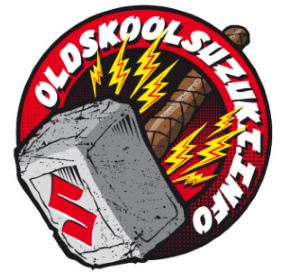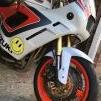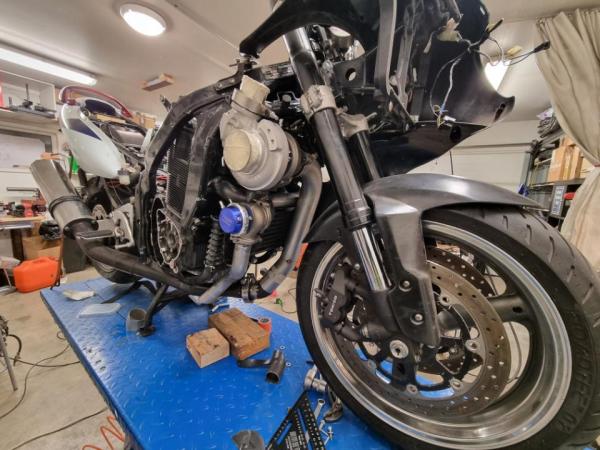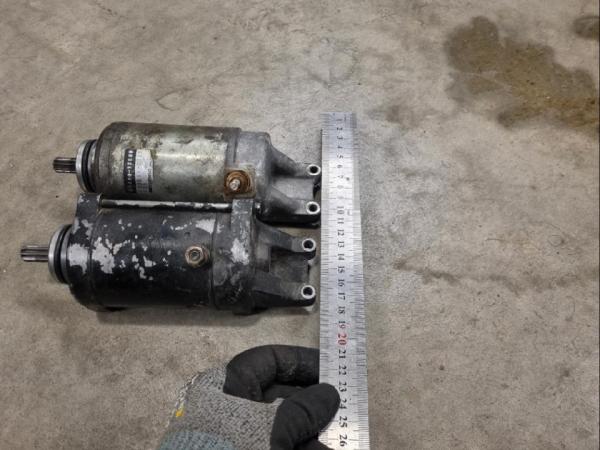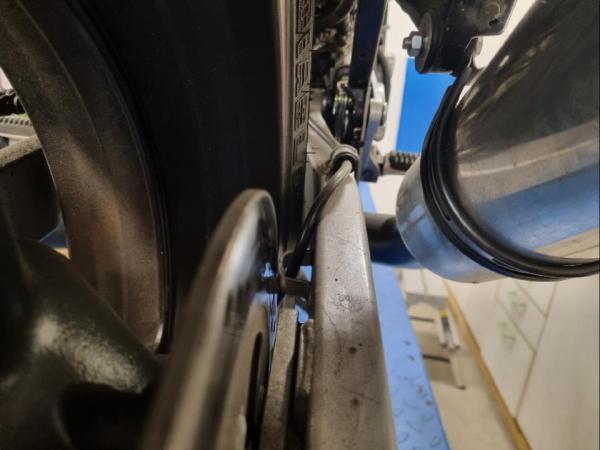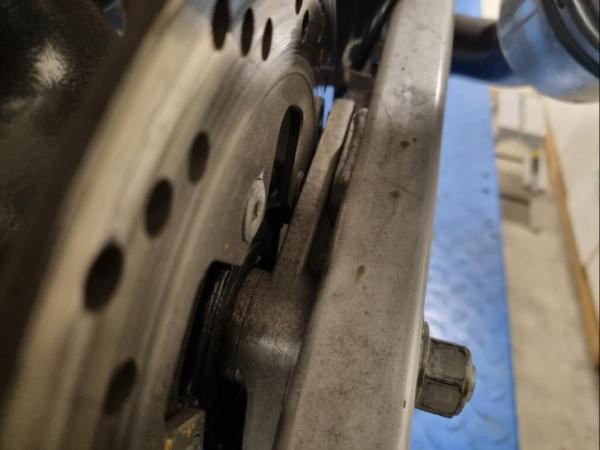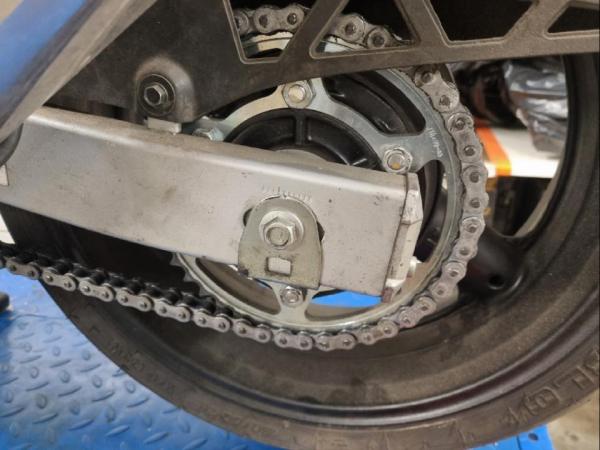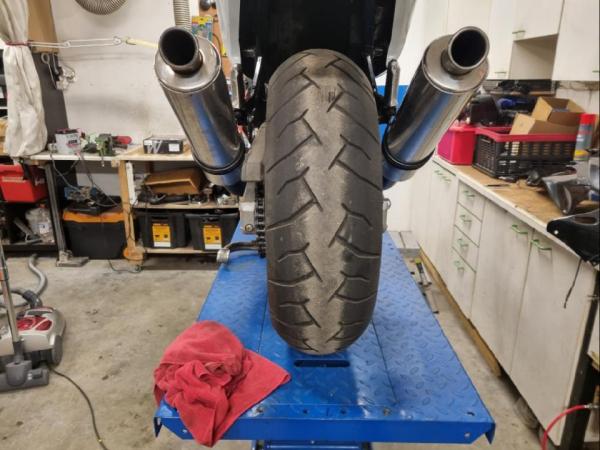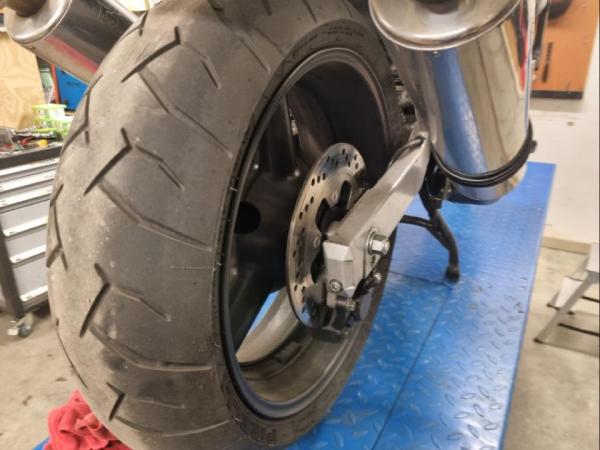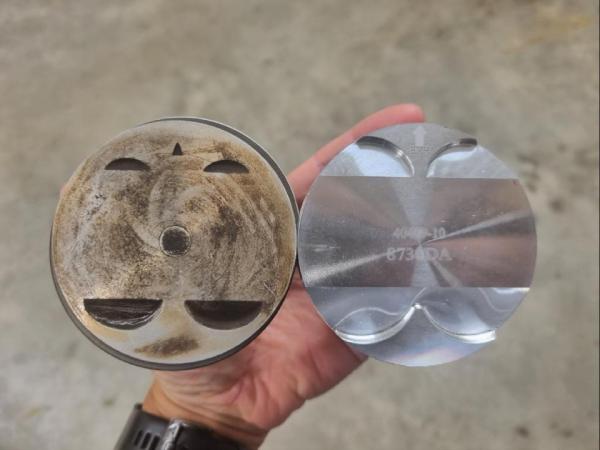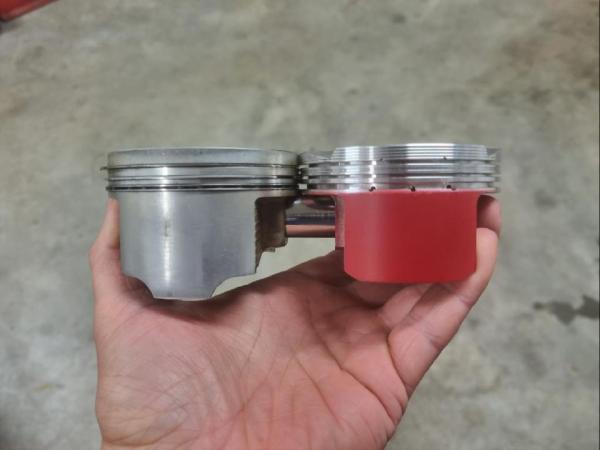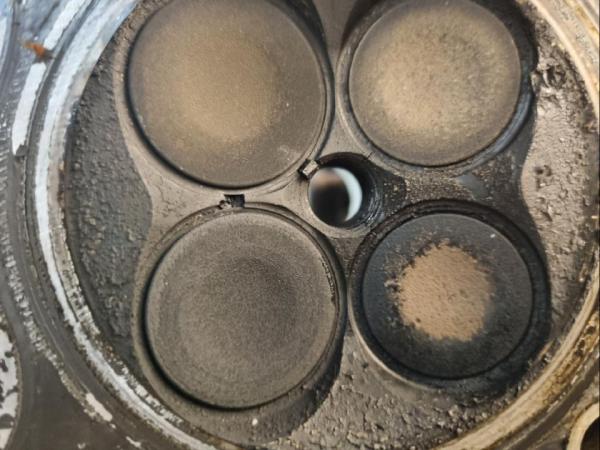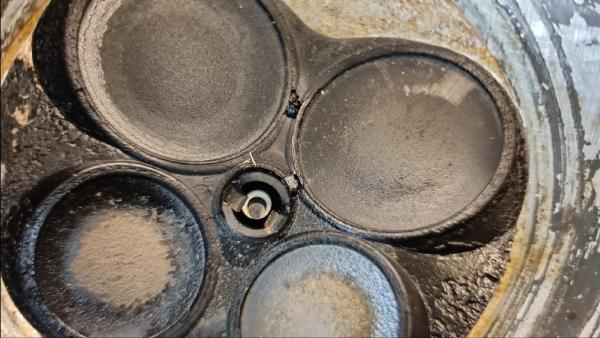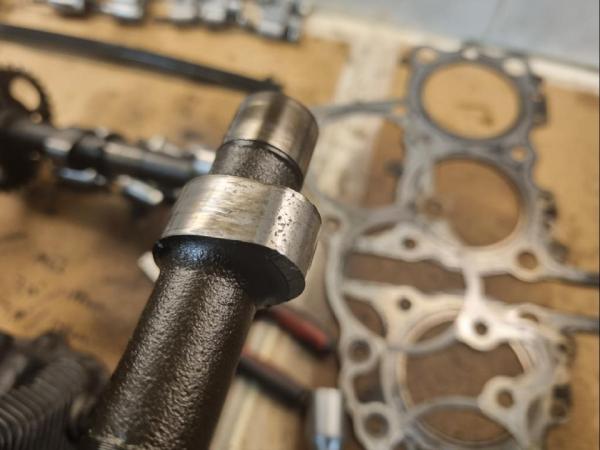

IhmeJanneFIN
Members-
Posts
50 -
Joined
-
Last visited
Reputation
50 ExcellentPersonal Information
-
Location
Finland
Recent Profile Visitors
760 profile views
-
Having done the mk1 750F (748cc) to a running 988cc Frankenstein with the 748 cylinders and 1127F crank, so I can share some info. Would it be usefull, it's up to you to decide. 1052 fill fit straight on (no modification needed), as is stated on the Frankenstein build and I believe the 748 and 1052 cases are the same? (correct me I am wrong!) 1127F/R (and I believe also 1157 cos "same" (timing gear different)) crank can be fitted to the 748 casings, BUT, the conrod #3 will hit the oil line running from the main gallery to the transmission bearing. This can me "dremeled" down to allow the crank to spin. BE CAREFULL THOUGH, you may go all the way to the oil line (ask me how I know, but copper brakeline fitted perfectly inside to fix the leak from the hole). Thats pretty much for the crank that is needed if my memory serves me right. The upstairs is the more complicated part. As the 748 casing is a bit smaller than 1127/1157, those bigger cylinderblocks don't go straight on and would need enlarging the cases (have been done by others). I believe 1052 would go straight on as 748 and 1052 use the same base gasket. Clutch must be matched to the crank: 1052 must use 1052 basket as the stroke is 58 mm. 1127/1157 must use basket intended for those cranks as 59 mm stroke. Stroke of 58 mm vs 59 mm clutch baskets have different amount of teeth. Lets not forget that 1127F uses helical cut gear at the crank, so only 1127F basket fits that. (And I believe also 1127G uses helical cut gears, but havent had one on my own hands, so cannot confirm.) 1157 must use 1157 timing gears, because of the hyvo chain. Basically this is one way, you could get 1052/1127/1157 with a 6-speed box. If I got something wrong, please correct me, so I can edit the possible wrong info away.
-
I have a "Turbosmart style" external wastegate, and it has 2 ports above diaphragm and 2 below diaphragm and also have 2 plugs and 2 nipples. What those are, are different positions to actuate the diaphragm, ie. if one port has an obstruction in front the port and you cannot put a hose to it, so you can plug it and instead use the other port. The one below is where you should put the boost reference and the above nipple is vented to atmosphere to allow the diaphragm to move. If you have ie. an electronic 3-port boost controller (and efi), the you would put a hose also to the nipple above the diaphragm as is instructed on the 3-port valve diagram.
-
Even better with few beers in sauna. Thats how the wild ideas appear to us Finns
-
Excellent info as usual Arttu, this is reassuring me to continue my engine build how I have thought to go. I currently have three springs to my external wastegate, 0,2 bar, 0,5 bar and 0,7 bar, so I will try to use the 0,5 bar as the base and run gasoline with only that and use my 3 port boost controller to achieve higher boost with E85. If my preliminary calcultions are good I can achieve the 9,5-10:1 CR with my 750F DOT head and correct heigth spacer and still have about less than 1 mm squish. Still have to do the dry build, but as family man garage time is quite limited, so everything takes ages to finish . It's funny though, here we are three finnish guys talking about flex fuel in english But this is very good info for all bike builders, so it is good to have this talk here
-
Good to hear, so I am now tempted to go something like 9,5:1 CR now with a DOT head. I am also planning on running charge cooling, but I will try the air to water method to see if that would work for me. I don't have any room for an air-air intercooler at the front as I am running full fairing and dual oil coolers with high mounted turbo for gravity drain. But I do have room for a radiator at the back under the seat and should be able to fit a charge cooling element inside the plenum (still working on that though).
-
As title says, has anyone experimented with flex fuel or even plain E85 on these old oilboilers with EFI and what CR people have used? I know that with E85 I could run OEM or even higher than stock CR and still run high boost, but petrol would like the lower CR better with boost. Powerwise I will be making the most power with E85 & high boost and propably would drive quite much with it near home, as my nearest petrol station has it. But I will also be running pump gas with when I go touring with the bike, so that I could go further between gas stations. As I am currently building my new engine to my turbo teapot (GSF based 1216 with oem busa pistons and Maxpeeding rods), I will be running EFI on it (Maxxecu btw) with big enough injectors so I have the possibility to run full flex fuel with it and three different boost maps which would all take acount the amount of E85 in the system. With different height spacers and heads (I have two different DOT heads and -92 GSXR shim head to choose from) I could achieve CR between 8,5-10:1 if my calculations and data entry to CR calculator are correct. With 8,5:1 CR would propably be best for plain pump gas and high boost, but would it be too low for E85? Something near 10:1 I think would be too much for pump gas on even low boost levels, but would be totally fine with E85. So is the in between say 9-9,5:1 the way to go with flex fuel? What do you guys think would be a good CR to go? Any opinios and more information on the topic are welcomed.
-
Not that familiar with oil cooled gixxers, so didn't realize in my first post that the slabside is the one that uses the 1052cc engine. With that 1052 engine, as far as I know, basically every small cc oil cooled should use the same size smaller starter as the 1052, but the gear may differ as partzilla gives different teeth idler gears for different engines (ie. 12/53 tooth on 1052 slabside (#12611-06B00) and 12/52 tooth on 748 teapot engine (#12611-27A01) ). So basically referencing which oil cooled engine uses the same starter idle gear, it's starter "should" bolt on? To make a bit more of a mess of things, you should be able to swap the idle gear to match the different starter, as the smaller gear teeth count stays the same, only the bigger teeth count (which connects to the starter) changes. 1127 and 1157 uses the bigger style starter, hence the "bubble" on the left engine cover, so the the o-ring mating surface is also different in size between 1052 vs 1127 style engines and won't fit.
-
I have -93 gsxr 750w starter on the shelf, which atleast according to partzilla is the same part# as gsxr 1100w. On the pic, above is the water cooled starter and below is gsf 1200 starter. Close, but not a direct fitment, the watercooled is a bit longer so the mounting holes don't line up. Might be able made to work by enlarging the mounting holes though. O-ring side seems identical and both use the same O-ring. Gear teeth match also. Hope this helps.
-
You can use even 600 or 750 unit, but the redline is too much for 1100 engine and may break by overrevving it. What ever unit you use, make sure to check the pinout is correct.
-
My take on this tread. I have -94 750 F with a 98+ swingarm. I have also used the 98+ knuckle and rods but still running the -94 shock. Need to upgrade it though as I have now fitted k7 gsxr 750 front end to the bike. Can't remember if there was need for spacers at the pivot, but atleast I can't see any there with my flashlight, so propably not. As a wheel I run gen 1 Hayabusa rim and 190 tyre. The rim was bought years and years ago from UK and it was already adapted to be used on a GSF 1200, so there are custom spacers not made by me. Rim still uses busa bearings. With the custom spacers an 20 mm axle can used and this comes from a GSF 1200 also I believe. Brake caliber and bracket is from a -93 GSXR 750W as I had one laying around and it has the possibility to use it without the brake caliber arm. Still run busa rear brake rotor. When fitting it to the 98+ F swingarm, I had to mill the 750W caliber bracket down "few" millimeters and weld stops to the swingarm to hold the bracket in place. And also had to mill the Busa sprocket carrier so much that there is not enough material to hold the seal on it anymore, so the bearing sealing is done only by the bearing seals itself. Not ideal, but time will tell how it will last. Might fabricate some sort of shield to it at somepoint to prevent debris going to the bearing like there is on the original F front wheel spacer. The axle holes on the swingarm were made bigger from 17 mm to 20 mm and I believe I am using the gen 1 SV650 chain tensioners (bought years ago and found them in my parts bin, so cannot be sure, but parts fiche pictures seem identical). Front sprocket is spaced out few millimeters and chain runs quite close to the frame and tyre, but it runs straight with my checkings and can't see any marks on the frame to see it's hitting it. Wheel is also centered on the bike, so all good there. Also the tyre runs quite close to the swingarm, but so far there doesn't seem to be contact with tyre and swingarm. I am planning on extending the adjustment slots and modifying the chain tensioner thingies to allow the wheel to move a bit more rearward to allow more room for the tyre to flex just in case. I don't like the look of the extended swingarms so will not run one, even though I am aiming to triple the engine power with my build. Will see how that will go though. Would I do it like this the second time to run wider tyre, propably not. Too much hassle and custom parts, but I had extra time at the garage and had parts already laying around. Previously I had a custom made widened and braced -94 swingarm, but when I made it I only had a fluxcore welder, so the welds on it weren't that good and it was little twisted after my work done to it, so I bought the facelift swingarm instead. To put wider wheel now, I would just buy facelift F rear wheel (4,5" wide) to be fitted on the facelift swingarm and run a 170 tyre on it and call it good as it would only be "10 mm" narrower than 180 tyre. Few tyre manufacturers state that their 170 tyre can be run on 4,5" wheel, but cannot remember which ones on top of my head. When using facelift swingarm, changing the rods (dogbones or what ever they are called) is much easier as they don't have any bearings as there is on the pre facelift rods. So swapping rear shock and adjusting rear height is much more easier with the facelift swingarm. But hopefully this post helps someone on their quest for wider rear wheel to F bike.
-
With my dry build I will check valve to piston clearance no matter what head, as I am planning on running non oem valvetiming. I saw bigger intake and exhaust valves and titanium retainers being sold at Abuso Racing site for quite reasonable price of 310€/set to many makes and models of bikes.
-
I kinda anticipated this answer from you Gixer1460 , as I remember you saying on some post on this forum, that you run shim head on your build without problems. Do you think stiffer valve springs would be a good idea, or can it be run as stock condition? B12 head is a big piece of paperweight, that I agree, there is no point in fixing that as it would be costly if even. Will keep it as spares though, as it has good valves still. The guy I bought those pistons from (local guy to me), had been basically selling them in half price for about half a year with no luck (I had been eyeballing the listing previously), so I reckon I would not be able to sell them either with good enough price to buy new turbo designated pistons, so this is what I will run now. They do look rather decent to my eyes, though I have never held a designated turbo piston in my hands so cannot tell the difference I need to get my block bored so I can start the dry build and calculate the CR those pistons will be in oil boiler, that would determine a lot which head to run. Would like to keep the squishband tight for better bang in the cylinder.
-
This thread seems like a appropriate place to ask about my head dilemma as it revolves around dot and other heads also. I am building boosted 1216 engine and I have in my possession 4 differend oil boilers and heads, each with it's own flaws (cheap engines so "minor" problems in these, more below). My compression ratio goal is about 8,5:1 and will be run with efi also flexfuel. Power targer around 300, but anything between 200-300 is acceptable. Engines are: -92 GSXR 1127 engine (shim head), at the moment assembled and cams look ok. Have not run when in my possession. Would rather not disasseble, so I would be able to use this in some other project as NA engine. Also shim head, so would need some rocker fork work done to use reliably in boosted engine. Have read otherwise also, so might be OK head, with just throwing new springs and titanium retainers (which also costly). -96 B12 engine, with damaged cams and cam liners (lot of alu and metal gone due to oil starvation at the top end due to broken oil pump). At the moment completely disassembled. Lower engine parts are ok (crank, cylinders, gearbox, clutch...), only the head is toast, so no good without some alu welding and machining the cam liners to spec again and new cams. Costly, if even doable? Will take the lower end of this engine to my 1216 build, but the metal clutch basket from the 1127R with 1127F inner (4 normal springs, no diaphragm, cheaper to fit lock up and better clutch to start with than B12 alu basket). -88 GSXR 750 aka the real DOT head and cams, with minor pitting on exhaust cam lobes and on 1 rocker. Also has minor damage on the #2 and #3 cylinders, as small bits of alu missing between valves and next to valve seat (small hole next to alu seat as there was alu stuck to it and took it out with pliers). So might need oversise valves to fix this head. Engine completely disassebled at the moment. Tempted to put big valves and stiffer springs to this head. And finally my first oil boiler ever. -94 GSX750F (currently 988cc Frankenstein). This engine is currently on the bike and running with the oem 750F dot head and cams. This engine might be a ticking bomb waiting to explode, so might disassemble this engine just to look how it has beared my small test runs. There is some brownish black flake seen in the engine oil, so the oilite bushings might be failing on the piston pins. But the head and mild 750F oem cams are in good condition. Would like to put stiffer springs to this one if going in use. So, my question is, which of these would be my best bet for the boosted 1216cc build? All need some sort of attention, just differend kind of attention before putting to use, so would like to do the headwork only once to the best plausilble head. And some backround info of build plan the help decide witch head to recommend. I have obtained very cheaply a set of unused gen 1 Busa Wössner pistons with 13,5:1 compression, which I plan to run on my engine with bored B12 cylinders. Bare in mind, these pistons are originally meant for Busa, so the advertised compression ratio of 13,5:1 is not achieved with these in the oil boiler. What the compression ratio will be, I don't know yet, have to do a dry build and calculate, BUT, the Wössners have a remarkable bigger valve pockets than B12 oem pistons but have the same compression height. So in my mind, these should have lower compression ratio than B12 oem pistons, but the same deck height and squishband as oem B12 pistons? Firstly I would need to get my pistons to fit my cylinders, to be able to check the deck height and calculate cylinder volume without the head with the wössners. I also know the dot heads will pump up the compression as it has smaller combustion chamber than the 1127/1157 heads, so it might bring the compression right on the ballpark or go way over the target with these wössner pistons. Will have to finetune the compression ratio and squishband with spacer plate if necessary.
-
It was originally about 3 litres if I can remember correctly, but it has been modified multiple times after that, so current volume is unknown. But it is much bigger in size than ie. Gsxr or Blandits that I have seen. I tried to mimic the oem gsx 750 f airbox in size and shape.
-
I saw some forum/internet post somewhere, where this thing was called "primary breather valve", but I think they didn't use 2 stroke reed valves, it had some more complex type of membrane valve Anyhow, there is small "vacuum" or "air movement towards cylinders" inside the plenum when the engine is running at off boost situations and these valves just reroute the air stream to be shorter, so rather than pulling the air through turbo and charge piping, it is drawn much shorter distance through the reeds. So better throttle response at off boost situations, and because there is better response from the engine, there is smaller turbolag? I don't, it just works. Atleast on my case they work very well, because before turbo starts building boost, it draws air through these reeds, as I can hear the induction sound from the reeds, but it stops as soon as there is movement on the boost needle. I still need to fabricate some sort of air filter for those reeds by the way. Without these reeds in my case atleast, it's much more sluggish from idle to around 3000-4000 rpm before the turbo starts to spool up.
